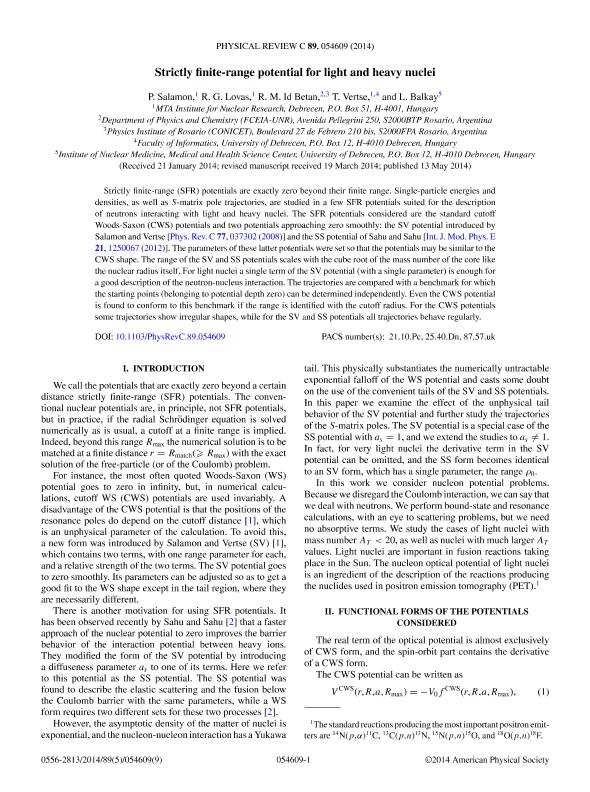Mostrar el registro sencillo del ítem
dc.contributor.author
Salamon, P.
dc.contributor.author
Lovas, R. G.
dc.contributor.author
Id Betan, Rodolfo Mohamed

dc.contributor.author
Vertse, T.
dc.contributor.author
Balkay, L.
dc.date.available
2016-05-27T21:22:58Z
dc.date.issued
2014-05
dc.identifier.citation
Salamon, P.; Lovas, R. G.; Id Betan, Rodolfo Mohamed; Vertse, T.; Balkay, L.; Strickly finite-range potential for light and heavy nuclei; American Physical Society; Physical Review C: Nuclear Physics; 89; 5; 5-2014; 54609-54609
dc.identifier.issn
0556-2813
dc.identifier.uri
http://hdl.handle.net/11336/5906
dc.description.abstract
Strictly finite-range (SFR) potentials are exactly zero beyond their finite range. Single-particle energies and densities, as well as S-matrix pole trajectories, are studied in a few SFR potentials suited for the description of neutrons interacting with light and heavy nuclei. The SFR potentials considered are the standard cutoff Woods-Saxon (CWS) potentials and two potentials approaching zero smoothly: the SV potential introduced by Salamon and Vertse [Phys. Rev. C 77, 037302 (2008)] and the SS potential of Sahu and Sahu [Int. J. Mod. Phys. E 21, 1250067 (2012)]. The parameters of these latter potentials were set so that the potentials may be similar to the CWS shape. The range of the SV and SS potentials scales with the cube root of the mass number of the core like the nuclear radius itself. For light nuclei a single term of the SV potential (with a single parameter) is enough for a good description of the neutron-nucleus interaction. The trajectories are compared with a benchmark for which the starting points (belonging to potential depth zero) can be determined independently. Even the CWS potential is found to conform to this benchmark if the range is identified with the cutoff radius. For the CWS potentials some trajectories show irregular shapes, while for the SV and SS potentials all trajectories behave regularly.
dc.format
application/pdf
dc.language.iso
eng
dc.publisher
American Physical Society

dc.rights
info:eu-repo/semantics/openAccess
dc.rights.uri
https://creativecommons.org/licenses/by-nc-sa/2.5/ar/
dc.subject
Strictly Finite-Range Mean Field
dc.subject
Complex Energy
dc.subject.classification
Física Nuclear

dc.subject.classification
Ciencias Físicas

dc.subject.classification
CIENCIAS NATURALES Y EXACTAS

dc.title
Strickly finite-range potential for light and heavy nuclei
dc.type
info:eu-repo/semantics/article
dc.type
info:ar-repo/semantics/artículo
dc.type
info:eu-repo/semantics/publishedVersion
dc.date.updated
2016-05-27T20:16:31Z
dc.journal.volume
89
dc.journal.number
5
dc.journal.pagination
54609-54609
dc.journal.pais
Estados Unidos

dc.journal.ciudad
New York
dc.description.fil
Fil: Salamon, P.. MTA Institute for Nuclear Research; Hungría
dc.description.fil
Fil: Lovas, R. G.. MTA Institute for Nuclear Research; Hungría
dc.description.fil
Fil: Id Betan, Rodolfo Mohamed. Universidad Nacional de Rosario. Facultad de Ciencias Exactas, Ingeniería y Agrimensura; Argentina. Consejo Nacional de Investigaciones Científicas y Técnicas. Centro Científico Tecnológico Rosario. Instituto de Física de Rosario (i); Argentina
dc.description.fil
Fil: Vertse, T.. MTA Institute for Nuclear Research; Hungría. University of Debrecen. Faculty of Informatics; Hungría
dc.description.fil
Fil: Balkay, L.. University of Debrecen. Medical and Health Science Center. Institute of Nuclear Medicine; Hungría
dc.journal.title
Physical Review C: Nuclear Physics

dc.relation.alternativeid
info:eu-repo/semantics/altIdentifier/url/http://journals.aps.org/prc/abstract/10.1103/PhysRevC.89.054609
dc.relation.alternativeid
info:eu-repo/semantics/altIdentifier/doi/http://dx.doi.org/10.1103/PhysRevC.89.054609
dc.relation.alternativeid
info:eu-repo/semantics/altIdentifier/url/http://arxiv.org/abs/1210.1721v4
Archivos asociados
